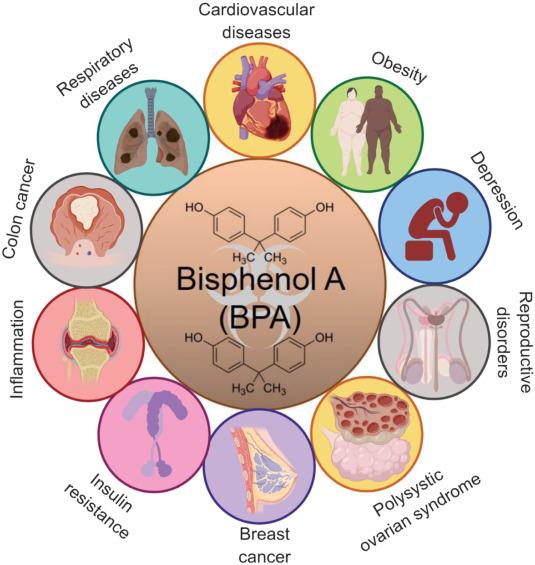Will Bisphenol A be the PFOS of Wind Energy?

Dr. ir. Eric Blondeel
PFOS
Poly- and perfluoroalkyl substances (PFAS) are chemicals that are man-made. They do not occur naturally in the environment. Examples of PFAS are GenX, PFOA (perfluorooctanoic acid) and PFOS (perfluorooctane sulfonates).
Teflon is the best known PFAS variant, used, among other things, as the non-stick coating of frying pans. However, PFAS substances are very toxic. They are blamed for a large number of serious health problems such as liver damage, testicular and kidney cancer, thyroid problems…
The problem is that they spread very easily in the environment. For example, PFAS remains were found on the Tibetan highlands and in Antarctica. They only disappear very slowly from the environment. In other words, they accumulate slowly and can accumulate to levels that are harmful to living things.
PFOS is used worldwide in lubricants, coatings, paints, varnishes, etc. Even from 1970 also in class B extinguishing foam for extinguishing chemical liquids. They are fluorine-based compounds with a high stability, which is why they were thought to be harmless.
Recently in the news
Minister Zuhal Demir of the environment was given this difficult dossier. One of the reasons why PFOS, one of the PFAS substances, has recently been in the news is the drastic reduction in the limits of PFAS. That only happened in 2018. Then there was an immediate alarm. Previously, it was assumed by politicians and the press that these products, although banned, were fairly harmless according to OVAM (p. 25). An agreement was reportedly reached between the minister and 3M to remediate the grounds around the factory. But that doesn't say anything about global pollution from the use of these PFAS substances.
Bisphenol A
Bisphenol A (or BPA) is a synthetic organic compound whose reactant is phenol and is used in the production of all kinds of plastics. The attached letter A indicates the use of acetone as the second reactant.
There are serious suspicions that Bisphenol A causes a disruption of the hormone action. That makes Bisphenol suspicious. It should be known that exposure to endocrine disrupting chemicals has been linked to about 80 diseases. These include testicular cancer, obesity and reproductive disorders.
The unborn and young children are especially vulnerable because their hormone system is still developing. As early as 2012, the World Health Organization warned about the potentially carcinogenic properties of endocrine disruptors and concluded that these substances pose a global threat to public health.
Will Bisphenol A be the PFOS of wind energy?
Bisphenol A is used as a base for plastics and epoxy resins. The fine dust of this is the known microplastics that end up in the atmosphere and the environment and are seen as a real Trojan horse, because in favorable atmospheric conditions Bisphenol A is quite stable, but when the conditions change Bisphenol A can leak out of the dust particles, dissolve or be released and become a hazard to humans and the environment.
So it's no wonder that the European Food Safety Authority (EFSA) recently significantly reduced dietary intakes of bisphenol A from a tolerable daily intake of 4 micrograms in 2015 to 0.04 nanograms per kg of body weight and per day.
Well, the reduction in Bisphenol A is probably going in the same direction as PFOS, with a reduction of a factor of 100 000. This is where the media attention is.
As early as 2012, the World Health Organization (WHO) warned the world about the possible carcinogenic properties of endocrine disruptors, concluding that these substances pose a global threat to public health.
Bisphenol A also poses serious problems for water. 1 kg of Bisphenol A makes 10 billion liters of water unusable. Keeping this substance out of the environment therefore becomes essential, even though Directive 2020/2184/EC allows values that are 37.5 times higher than the WHO recommendation.
There is still a long way to go here.
Bisphenol A and Wind Turbines
Wind turbine blades are made of fiberglass impregnated with epoxy to make them stronger. Epoxy contains 30-40% of Bisphenol A. Result: the particulate matter that comes from eroding windmill blades therefore contains a high content of Bisphenol A.
And we already wrote that Bisphenol A is very harmful.
Wind turbine blades are the largest consumer of epoxy plastics. In 2013, 27% (69,000 tons) of all epoxy resin went to wind turbine production. The annual global production of Bisphenol A in turn is more than 10 million tons, and a significant increase is expected in the coming years.
That raises serious questions
In principle, BPA in epoxy should not be a public health problem because it is encapsulated in the epoxy matrix and the wind turbine blades are given a protective coating.
The practice is different, especially due to the enormous tonnages of windmill blades that are susceptible to wear. We already mentioned that there are great risks that Bisphenol A could enter the environment precisely via the wind turbines.
The cat and the proverbial bell
The cat's bell was rung by a publication from the Norwegian Turbine Group and also in OpinionZ.
Especially the leading edge of the blades of wind turbines are subject to severe erosion. Although the erosion of windmill blades is the biggest problem for windmill manufacturers and belongs to their core business due to maintenance and repair costs, no verifiable data is available about the problems mentioned here. And if there are graphs in folders, the figures have been deleted. Remarkable all!
In 2021, the University of Strathclyde published the measurement data of wear simulations on uncoated P10 epoxy under weather conditions of rain and hail. The aim was to produce a map showing the intensity of erosion for wind turbines.
However, those measurement results were in principle not directly usable for blades, because only the wear of the leading edge of the blades is dominant.
But the results were used by the Norwegian Turbine Group to calculate the amount of epoxy dust for the entire surface of the blades. That gave no less than 62 kg. epoxy dust over the total surface per year!
Remember that epoxy contains 30 to 40% BPA.
That alarming number was (rightly) strongly disputed: some came to just 150 grams per year.
Factcheck Flanders also responded. She states that the erosion amounts to 640 grams per turbine per year. Unfortunately, fact checker also makes a big mistake because they used unverifiable data. After all, the wind industry is extremely discreet, closed and unreliable. Interest groups such as the World Wind Energy Association or the Brussels-based Wind Europe do not release anything, not even statistics on hazards, accidents, safety, health, or human suffering.
And what is released turns out to be wrong, for example, in 2014 there were 117 known tower fires worldwide while the industry reported only 12 Fire is the second largest wind turbine problem after blade wear that releases many toxic substances…
Something is brewing
For example, the front edge of the blades is only given a 5-year wear guarantee.
But Siemens Gamesa had to perform an "emergency" blade repair on 140 of the 175 turbines at the 630 MW supplying London Array wind farm in March 2018 due to earlier-than-expected leading edge erosion.
This came a month after Siemens Gamesa was forced to repair 87 of the 111 turbines at a 400 MW farm in Anholt, Denmark. Both cases involved 3.6 MW turbines with a rotor diameter of 120 meters and installed in 2013.
The fact that these relatively small turbines are already showing advanced erosion on such a scale in less than five years emphasizes the seriousness of the problem facing the (offshore) wind industry.
It is not known how much material has ended up in the environment, nor is the cost of the repair known. Spare blades were even fitted during those repairs.
The fact is, however: erosion is now one of the main reasons for wind turbine failures. In addition, it turns out that most of these repairs only last a few years.
It can be expected that the problem will even worsen. On the one hand, this is due to the increase in wind turbines at sea, where the wear is 40% higher, and on the other hand, the pursuit of larger diameters of mill blades and higher blade speeds (to reduce investment costs) results in even greater erosion and therefore more damage to the environment.
And then there is the EIA
'Environmental impact assessment' is an investigation into the possible environmental consequences of certain activities or interventions (projects, plans, policy intentions or programmes). An environmental impact statement (EIA) is drawn up before the projects or plans are implemented. In this way, harmful effects for the environment can be estimated and dealt with at an early stage.
In the “Nevele Judgment”, EU regulations require that a construction permit for wind turbines is subject to the EIA report.
In the interest of public health, windmills must meet additional requirements. Currently, the noise generated by windmills is already such a new requirement for public health.
Since it is now undeniably established that windmills also cause chemical pollution with hazardous substances such as Bisphenol A (BPA), a substance that the WHO calls a worldwide threat, 1 gram of which makes 10 million liters of water toxic and that is harmful to humans, animals and the environment, it is essential that this matter is included in the EIA.
Wind turbine blades release from 0.5 to 2.5 grams of pure Bisphenol (BPA) per year. Perhaps a much too low figure compared to the FactCheck Flanders figure. Calculated over a lifespan of 20 years, this equates to the destruction of 100 million to 500 million liters of water per turbine. Not exactly negligible as this ends up in the diet and even in the bloodstream. But even that figure is probably an underestimate, given the reputation of the wind industry.
The wind energy sector has probably seen this storm coming for a long time and according to the article Hidden Interests in Literature Wind Turbines of the University of Twente, the sector controls/manipulates. They appease unsubstantiated minimalist figures and try to keep the publications under control: “the wind energy industry manages to manipulate by keeping a constant flow of information in the discussion around wind turbines, in order to divert attention from independent scientific research into the health effects and risks of wind turbines on humans and animals. Administrators and researchers need to take a more critical look at research funding and what influence industry may have had in scientific publications.”
To date, administrators have meekly followed the wind energy lobby, but now the ill effects are emerging and ignoring it is becoming a political hot topic.
Another huge problem that the EIA has to deal with is that there is still no solution for salvaging the worn blades that weigh up to 60 tons and need to be replaced every 15 to 20 years. Sawing and burying is very harmful to the environment, also because Bisphenol A then permanently leaks into the groundwater. With the regularity of a clock, companies claim to have a solution, but without release on which the claim is based.
Environmental Organizations?
It is striking that environmental organizations always talk about the application of the precautionary principle when there is even the slightest doubt. Just think of pesticides and the daily display of the requirement for a circular economy. But about Bisphenol A and buried turbine blades they are silent.
Now that wind turbines end up in the danger zone from an environmental point of view, there is no wind. The Scottish government has already woken up.
PFOS rightly caused a lot of controversy. But if you look at the Bisphenol A (BPA) file, you wonder whether the windmills that are scattered all over the landscape will not create an equally large and dangerous dust cloud.
We therefore end with the question:
When will policy makers wake up or will it be another PFOS story?
See also —
1 - Study: Bisphenol A, Bisphenol F, and Bisphenol S: The Bad and the Ugly. Where Is the Good?
2 - Report: Bisphenol A – an Environmental and Human Threat
3 - Bisphenol A in wind turbines damages human fertility
4 - Bisphenol A and the environmentally destructive nature of industrial wind turbines























